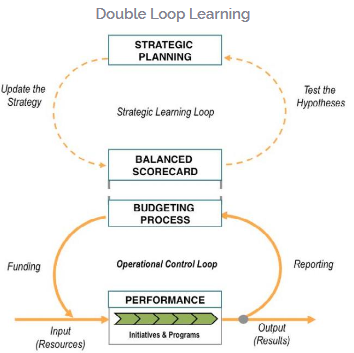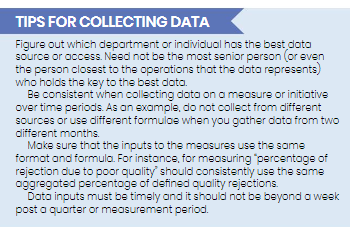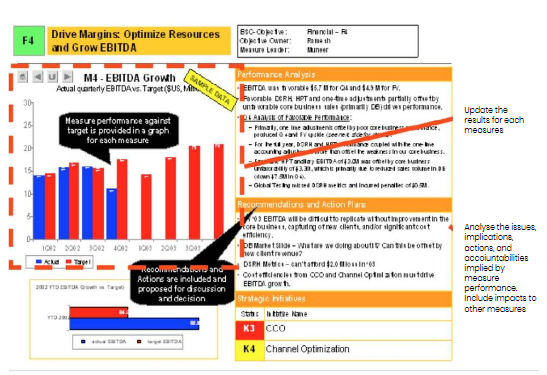- October 18, 2020
- Performance analysis
Here is how you can drive strategic performance using the 'secret sauce' called strategic performance analysis, which includes gathering, organizing, measuring, analyzing, and interpreting data.
In the Art of War, Sun Tsu says: “Strategy without tactics is the slowest route to victory! Tactics without strategy is the noise before defeat.”
Globally, nine out of 10 organizations fail to execute their well-thought-out strategy. Is it because the strategy was bad or the tactics didn’t work? How can they know for sure? Assuming most organizations have some kind of strategy, how can they get the tactics right to succeed faster? As a top CEO once said, he would trade a mediocre strategy well executed to a great strategy poorly executed.
Over the last two decades, we have been helping enterprises across the globe and industries find better results from their strategy. Here is how you can drive strategic performance using our “secret sauce” called strategic performance analysis, which includes gathering, organizing, measuring, analyzing, and interpreting data.
The objective is to know how well you are managing the strategy, which incidentally is a set of hypotheses that if we do some of those things, we will achieve what we set out to get. Knowing whether your hypothesis is working or not early in the year will help you fine-tune the plans. The process will help in identifying areas for improvement and guide the leaders to overcome the barriers to execution. Done right, this is a very powerful process to drive performance.
A strategic performance analysis involves both quantitative and qualitative data, and making the right interpretations based on sound judgment – what senior leaders are expected to do but so few practice. That’s why it is both art and science, and probably why few leaders are good at it. Here’s a straightforward process that will help top management to master the strategic performance analysis and I can assure you it has worked well for our clients to get more out of strategy.
Strategic performance analysis is not about individual performance but of the overall enterprise and whether it has achieved its strategic objectives that lead to realizing the vision and mission. By making use of data, we can check the assumptions about the cause-and-effect linkages between outcome and driver objectives. A balanced execution agenda framework with themes, perspectives, and objectives will be very handy. The four perspectives typically include financial, customers, internal process, and learning and development for private enterprises and stakeholders, internal process, learning and development, and resources for non-profit and government organizations.
By mastering the performance analysis of the strategy the top management can continually assess the progress they are making, see the opportunities from the market quickly, and work on weak areas for driving better results. It forms a major part of governance that a good enterprise should have – and indeed by governments too that have never executed their policies well in the last 73 years in India.
When the top leaders learn the nuances of cause and effect linkages that form their strategy, they will be wiser, and that will help their planning process, resource allocation, and governance. The double-loop learning that results from strategic performance analysis will help the organization and its leaders in two ways: to make operational changes and modify strategic planning.
Figure 1 below represents the double-loop learning process. Strategic learning is the top loop where the leaders collectively assess if the strategy implementation is working as planned or it requires changes in view of new technologies, competitive forces, regulation, or, say, the pandemic. The bottom loop is where the operational learning happens. Leaders can decide where to allocate resources to improve performance and to force focus on critical opportunities that crop up when new changes occur. Done well, this could speed up the information exchange and get the bad news from the market quickly to the top – a most important requirement in the current world where competitive advantages don’t last long.

One of our clients, a leading supermarket chain, was able to get huge insights on their strategy using the double-loop learning. Their initial strategy was to become the best service retail chain with a customer intimacy strategy. While their performance was not up to their internally set expectations, it was not bad in comparison with rivals. The double-loop learning was that the differentiation of intimacy was not really important for a market driven by discounts and lower prices. They then changed the strategy to focus more on operational excellence with efficient – not exceptional – service, better supply chain management and new, higher quality store brands. The objectives were changed accordingly and followed the same process of performance analysis and revision every month. Three years later, they sold the chain at a good valuation to a private equity fund.
In our experience, a successful performance analysis of strategy requires three key roles and the executives who take up these roles should work together.
- Objective owner: He or she who is responsible for a strategic objective will be responsible for analyzing, anchoring discussions, and preparing relevant reports. He or she will have to present the performance analysis of the respective objective. The actual preparation of the report could be delegated to the Measurement leader but the analysis of data and interpretation are the responsibility of the objective owner.
- Measurement Leader: He or she collects and provides a basic level analysis of data for individual measures and prepares presentation slides for the leadership team. The measurement leader has primary responsibility for preparing the performance analysis.
- Review Champion: This individual manages the overall performance review process, collects and assimilates all slides and charts in a report form, and coordinates with all strategic objective owners and measurement leaders.
These three roles working together can help leaders explore a few critical questions: How are we doing? What are the things that drive our current performance? How are the various objectives performances affecting one another? Are the assumptions of our strategy working? What are the changes we need to make to deliver better performance?

The strategic performance analysis involves a six-step process, which one should follow in the same order to get the best results.
Stage 1: Collection of Data
- Check the validity and logic of themes, perspectives, objectives, metrics, and initiatives. Before collecting data check if any of the definitions of objectives have changed with respect to the overall strategy. Check also if your data sources for measurement have changed. Do you have initiatives with clear milestones to bridge strategic gaps?
- Collect the most current as well as historical information on measures and initiatives. Data are contained in many different sources internally: Accounting software, data warehouse for historical data, etc. You can also do surveys and interviews to collect data from customers, suppliers, etc.
- Collect external information such as regulatory, industry or arena, and others such as competitors, vendors, etc.
Stage 2: Analyzing Data
- Update objectives, measures and initiatives using the internal and external data that you have collected in the earlier three steps. This consists of editing the definitions of objectives and measures and also adding the latest data. When updating strategic objectives, bring clarity to the cause-effect linkages and also definition. As for measures, graphical representation with the latest data is best for easy understanding and discussions. Do that with the actual performance of the current period against target and also year-to-date.
- Analyze trends and cause-and-effect relationships in the data. This step is the core of strategic performance analysis process. Here’s where the leaders get insights into how well the enterprise is executing its strategy. It will also throw up the challenges to execution and what the causes to those problems are. The data must be analyzed at multiple levels – enterprise strategy, themes/perspectives, objectives, measures, and initiatives.
When you analyze measures, ask yourself some of the following questions:
- Is the measure the right one for the particular objective?
- Does it accurately communicate the strategy?
- Is the lead measure driving the desired behavior?
- Are the links between measures in the same perspective or theme making sense?
Similarly, there are different types of questions you should ask for overall strategy, objectives, targets, and initiatives.
We have the unique process for analyzing performance and one of the things we do is using three different types of analysis, mainly to establish the cause and effect relationships between outcome and driver objectives and measures. Most leaders are familiar with these three types of analysis but they rarely do that in the right way, leading to poor analysis and understanding of the strategic performance. These are the three different types of analysis:
- Trends: Evaluate the same type of data over several successive measurement periods, typically monthly for the first year and then quarterly.
- Similar Relationships: Examine the same type of data from different units or departments or functions.
- Root Cause: Deep dive into the actions and events that you believe have generated the overall performance. You may use Fish-Bone or the IIAA (Issue-Implication-Action-Accountability) framework for this.
Summarise your findings in qualitative and quantitative terms. The objective here is to prepare the ground for the strategy review meeting of the leadership team. This is the ultimate aim of the performance-analysis process.
The quantitative data that are gathered for measures should be color coded with traffic signal colors (Green for target achievement, amber for warning, and red for problem alarm). It is not enough to have just quantitative data even if captured in attractive graphs, and so describing the interpretations of the same by the objective and measure owners is very crucial for facilitating stimulating discussions around the strategy.
The qualitative summary should address issues on current results, connections to other objectives, problem areas, caveats, improvement possibilities, risks, and recommendations.
 Fig 2 above shows a typical summary template for one objective (Source: CustomerLab).
Fig 2 above shows a typical summary template for one objective (Source: CustomerLab).
Most leaders face difficulties in preparing strategic performance analyses. Some are good with quantitative stuff and most do not apply their minds to the qualitative part. It is imperative that you as part of the senior leadership team ask the following questions while planning strategic performance analysis:
What types of data your organization currently gathers for performance analysis? Who gathers what? How does your organization make use of the data? What kinds of questions executives responsible ask about what is seen in the data? How do you currently summarize performance data? What’s working well – and what’s not – in your organization while preparing for performance analysis? What changes might merit progress?
Author: Dr. Muneer
Categories
Archive Post





